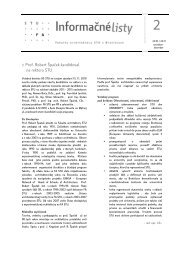ALFA 3-4/2005 - Fakulta architektúry STU
ALFA 3-4/2005 - Fakulta architektúry STU
ALFA 3-4/2005 - Fakulta architektúry STU
Create successful ePaper yourself
Turn your PDF publications into a flip-book with our unique Google optimized e-Paper software.
Ročník 9<br />
3-4 / <strong>2005</strong> ARCHITEKTONICKÉ LISTY FA <strong>STU</strong><br />
of human engineering chairs can adopt forms that were more<br />
suited to sit the human body. The seat and back started to be<br />
moulded in a way that closely followed the line of the seated body.<br />
Thanks to the economic boom in postwar America and later in<br />
Europe there was a huge demand for domestic furniture. This era<br />
was a hopeful and forward-looking period in the history. Many<br />
architects – designers concentrated their talents on<br />
the development of innovative furniture rather than on architectual<br />
projects. Manufacturing companies were able to offer the low-cost<br />
and yet high quality Modern furniture.<br />
Highly influential chair<br />
design has been<br />
introduced by “DAR”<br />
(Dining Armchair Rod)<br />
and a group of shell<br />
chairs and armchairs<br />
with different base in<br />
1948 by Charles and<br />
Ray Eames. This was<br />
the first chair with a shell<br />
seat 3D moulded in fibre<br />
glass. With this design<br />
the Eames had won<br />
the second prize at<br />
the international competition<br />
“Low-Cost Furniture<br />
Design”. This fibre<br />
glass design had meant the turning point in the history of chair<br />
design – it had achieved till that time unrealized organic unity of<br />
design and had influenced many other designers in the next<br />
future.<br />
Influenced by Eames’s research Marco Zanuso began exploring<br />
the potential of foam rubber as a suitable material for upholstery.<br />
In 1950 the “Antropus chair” by Marco Zanuso was the first design<br />
using latex foam.<br />
By the mid 1950s, the chair became even more sculptural in<br />
form, still with the goal to accommodate the human body better<br />
This sculpturality effected the chair becoming one of the central<br />
points of the modern interior. With domestic interiors becoming<br />
generally smaller in scale, more multi-functional, being used for<br />
such purposes such as writing, dining and lounging.<br />
With the rise and celebration of popular culture in the 1960s,<br />
the status of the chair has rapidly changed. In this era of booming<br />
consumerism a chair started to be percieved as a disposable<br />
short-lived object. A lot of designers tried to change<br />
the tradition that had associated furniture with high cost and long<br />
lasting permanance. Peter Murdoch and Peter Raacke presented<br />
their view on this trend by designs constucted from paperboard<br />
and cardboard. In the period of history when production was<br />
- 45 -<br />
orientated to the youth based market, the chair was no longer<br />
seen as durable product for the home, but as a lifestyle accessory<br />
of fashion. Confirmation of this approach was the introduction<br />
of new seating formats – inflatable “Blow chair” designed in 1967<br />
by Jonathan De Pas, Donato D'Urbino, Paolo Lomazzi and Carla<br />
Scolari as well as the “Sacco chair” – beanbag seat designed<br />
by Piero Gatti, Cesare Paolini and Franco Teodoro in 1968.<br />
Gaetano Pesce's “UP” series (mouldied polyurethane foam<br />
covered by stretch fabric) of seats can also be included among<br />
these new formats. These revolutionary innovations combined<br />
with availiability of “flat–pack” furniture greatly simplyfied the act<br />
of purchasing – a chair could be now bought right from the shelf.<br />
This fact also confirmed transformation of the chair from a durable<br />
product to a lifestyle accessory. Main furniture manufacturers<br />
realized that the only way to maintain their position within<br />
the market was to accelerate research and development projects<br />
with the goal of creating new seating formats. Significant progress<br />
was achieved in the area of injection–moulded plastics. Using<br />
of thermoplastics such as polypropylene and ABS, new<br />
possibilities had been open to the manufacturers of Modern<br />
furniture. During this period, Italian designers such as Vico<br />
Magistretti, Marco Zanuso or Joe Colombo were assisted in<br />
establishing the status of plastics as materials of quality and<br />
luxury through their Modern chair designs.<br />
The first chair completely made like single-piece construction was<br />
designed by Verner Panton, ironically a Scandinavian. With his<br />
cantilevered “Stacking chair” (known as well as “Panton chair”)<br />
Panton realized Eero Saarinen's unrealized ambition of total<br />
design unity.<br />
The global recession of the 1970s terminated previous era<br />
of popular consumerism. More conservative approach to design<br />
within the industrial mainstream started to be prefered. The chair<br />
was now more seen again as equipment for sitting. Smaller<br />
markets and cost reductions as an effect of recession pushed<br />
designers and manufacturers to return to a rational approach.<br />
Rodney Kinsman's “Omkstak chair” from 1971 is the example<br />
of design that period with using industrial materials while<br />
expressing a machine aesthetics.<br />
The prevalent conservativism within the furniture industry during<br />
the 1970s caused formation of several radical design groups in<br />
Italy. Global tools, Superstudio, Archizoom and Gruppo Strum, all<br />
questioned the philosophy of Modernism and signalled a mode<br />
of design based on spontaneous creativity and philosophical<br />
pluralism. In 1976 Studio Alchimia has been established.<br />
Alessandro Mendini was the leading protagonist of this highly<br />
influential design group. His redesigns of Joe Colombo's “4867<br />
chair” to which he applied a faux marble finish and Gio Ponti's<br />
“Superleggera” to which he ironicaly attached yachting signs,<br />
ironizing so called Good Design. Noisy anti-commercial and<br />
intellectual in content, Studio Alchimia used decorative ornaments<br />
to express its believe that the Modernism is dead.

















